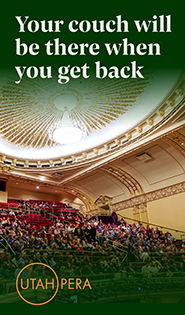Sierra’s “Bird Symphony” soars in a rich Utah Symphony program

World premieres of orchestral works are sometimes fraught with mishap, and worse, indifference. Where a new piece is tucked away between Beethoven and Shostakovich, it is sometimes under-rehearsed, misinterpreted, or under-appreciated by an audience.
Fortunately, in Thierry Fischer and the Utah Symphony, Arlene Sierra—the orchestra’s composer-in-association—had the privilege of premiering her Bird Symphony with a conductor, ensemble and audience who know her work well.
After hearing her Nature Symphony last week and her tone poem Aquilo earlier in the season, it was thrilling to hear her apply her distinctive voice to a powerful new piece that provided a triumphant capstone to her season-long collaboration with the orchestra.
Music director Thierry Fischer programmed the Bird Symphony this week as part of a progressive musical meal that began with Haydn’s Symphony No. 11 for 20 instruments and gradually added more until culminating in the full sound of Elgar’s triumphant tone poem (Alassio) In the South. Along the way, the audience was treated to Nielsen’s Clarinet Concerto featuring soloist Anthony McGill.
Sierra’s Bird Symphony shares many similarities with her Nature Symphony, including its motivic development and use of layered ostinati to imitate natural processes. In the new work, most of the motivic material came from actual bird calls, but Sierra developed them into something new, ecstatic, and far from its avian inspiration
The first movement, “Warblers,” began with an urgent energy, its source material sounding like a bird sensing danger. As the call ricocheted throughout the orchestra in a series of layers and loops, Sierra created a completely alien soundscape. It was as if we were seeing a frightening world through the warbler’s eyes or perhaps the warbler had flown us to a strange and uninhabited planet. Aided by four percussionists—including both xylophone and marimba—the orchestra built to an intense rhythmic climax.
In “Hermits and Captives,” (second movement), the orchestra responds to a recording of a Hermit Thrush call with transcriptions of birdsong from finches and canaries. Over a drone in the cello and mournful tones in the piano and double bass, a plaintive melody in the flute rose and spread to the strings, where it dissipated into pizzicato. As in the second movement of the Nature Symphony, Sierra used sustained low notes to create a dark, atmospheric mood. In the Bird Symphony those notes are a slowed-down bird call, which spread to horns and low brass, creating a powerful sense of motion, and transforming the movement from merely atmospheric to something more substantial and profound.
Driven forward by the marimba, Sierra’s trademark ostinati were at their most mesmerizing in the third movement “Female Birdsong.”
The finale “Utahraptor” created an infectious rhythm that took the audience on a primordial journey from birdsong to whatever noise its dinosaur ancestor might have made. The rhythmic motives were particularly effective when they spread to the bassoons, creating a unique and delightful sound, and led to an exciting, unique climax.
About a third of the audience gave Bird Symphony a standing ovation, which is quite a feat for a 25-minute long, sometimes discordant piece.
The program began on a more intimate scale, with the Haydn symphony. The 20 musicians played standing, classical era style (cellists apart). This appeared to heighten the musician’s engagement with the piece and with each other, as they leaned and swayed with each phrase, providing a historic sense of what performances would have been like in the Esterhazy court. The harpsichord provided a delightfully antique complement to the vibrato-less string playing.
The orchestra’s sublime rendition of the Andante first movement highlighted Haydn’s subtlety and depth, with a singing melody propelled forward by steady contrapuntal line and punctuated by tasteful cadences in the horn. The two ensuing movements—a busy Allegro and a stately minuet— were put across with crisp articulation, clear cut-offs, and well-phrased slurs accentuated the joy and playfulness. The spritely finale showcased the orchestra’s synergy, as the musicians nimbly traded runs and nailed each ornament.
Nielsen’s Clarinet Concerto opens with a phrase that sounds like it could be from Haydn or even Bach, but chromaticism soon enters the chat, and it becomes clear that the piece is in the Neoclassical idiom with a modernist slant. Written in 1928, the one-movement concerto also features moments of stunning lyricism, tinged with a dissonance that seems to stop them from being fully romantic.

Anthony McGill, whose day job is principal clarinetist with the New York Philharmonic, displayed a keen understanding of the concerto’s different moods and lent his charisma, musicality, and fearsome technical skill to the performance. He attacked the opening passages with panache, and Fischer let him set the tone in the slow lyrical passages, with the orchestra providing depth and nuance.
The soloist made a coherent musical statement out of the somewhat jumbled cadenza, in which the piece’s main themes are juxtaposed in a seeming argument. The snare drum plays a particularly important role in the piece—at times providing the only accompaniment to the clarinet—and principal percussionist Keith Carrick acquitted himself well.
For those who may have been left behind or slightly baffled by the Bird Symphony, Fischer closed with a rapturous rendition of Elgar’s ultra-Romantic tone poem In the South. Principal violist Brant Bayless played the solo passages with gorgeous phrasing and a generous tone. Fischer achieved a rich, full, and varied sound from the orchestra and captured the piece’s emotional contrasts.
After intermission Fischer read a message of solidarity with Ukraine and the orchestra performed a rousing rendition of the Ukrainian national anthem, for which the audience stood.
The program will be repeated 7:30 p.m. Saturday at Abravanel Hall. www.usuo.org

